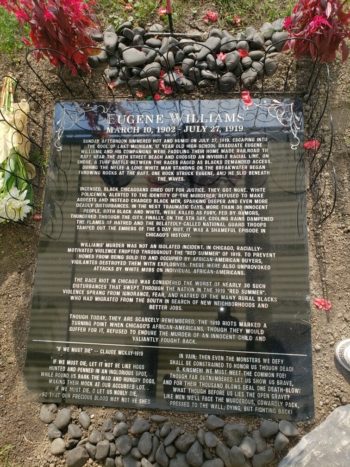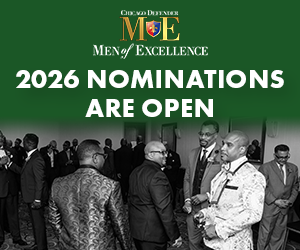 A headstone was unveiled Saturday to honor and remember the 1919 Chicago race massacre victim Eugene Williams at the historic Lincoln Cemetery. The Eugene Williams Memorial Committee, David Browning, Tammy Gibson, Scott Priz, and Michael Torney raised money for a proper headstone for Chicago’s first victim of one of the deadliest race massacres in the United States.
A headstone was unveiled Saturday to honor and remember the 1919 Chicago race massacre victim Eugene Williams at the historic Lincoln Cemetery. The Eugene Williams Memorial Committee, David Browning, Tammy Gibson, Scott Priz, and Michael Torney raised money for a proper headstone for Chicago’s first victim of one of the deadliest race massacres in the United States.
On July 27, 1919, Eugene Williams went swimming with some friends on a raft at a segregated beach on 29th & Lake Shore Drive. Williams’ raft accidentally drifted across an invisible line into the whites-only section. A white beachgoer saw Williams’ on the wrong side of the beach. Stones were thrown at that caused Williams to drown. Williams’ death sparked what became the Red Summer of 1919. For seven days, thousands of blacks and whites fought, resulting in injuries, homes destroyed, and the deaths of 23 blacks and 15 whites.
Several victims are buried at Lincoln Cemetery including John W. Simpson, a patrolman who was shot and killed at the 31st Street Station during the race riot. Simpson was 30 years old. The committee used their contacts to raise money, most of which the majority of the money came from the men of Omega Psi Phi Fraternity, Inc. Sigma Omega Chapter. Speakers were invited to talk about the significance of honoring Eugene Williams and the importance of learning about the 1919 Chicago Race Massacre.
“As we travel through history, we know names like Tamir Rice and George Floyd. We have to remember Eugene Williams,” Sean Long, 1st Vice District Representative of Omega Psi Phi Fraternity, Inc., Sigma Omega Chapter said. “The fact that a diverse group of people came together to ensure history does not forget the injustices. It’s amazing how you were able to do that, and this should be celebrated. This is a celebration that we remember what happened to Eugene Williams,” Representative Mary Flowers said.
 “It is clear that the 1919 Chicago Race Massacre was a pivotal point, perhaps the pivotal point in the modern history of this city. Addressing the crisis, changing the narrative, and reckoning with the poor choices that made this a city that works for some far better than others. Eugene Williams, rest in peace and power. Know that we come back a century to embrace and celebrate you. Know that we are working to build a better city. One in which those like you will enjoy every chance to swim, play, learn, grow and be the human beings you so clearly were up until that summer day. This is our promise to you in life and struggle and our tribute to you in lasting memory,” guest speaker Prof. Adam Green said.
“It is clear that the 1919 Chicago Race Massacre was a pivotal point, perhaps the pivotal point in the modern history of this city. Addressing the crisis, changing the narrative, and reckoning with the poor choices that made this a city that works for some far better than others. Eugene Williams, rest in peace and power. Know that we come back a century to embrace and celebrate you. Know that we are working to build a better city. One in which those like you will enjoy every chance to swim, play, learn, grow and be the human beings you so clearly were up until that summer day. This is our promise to you in life and struggle and our tribute to you in lasting memory,” guest speaker Prof. Adam Green said.
Prof. Franklin Cosey-Gay and Dr. Peter Cole, founders of the 1919 Chicago Race Riot Project, hosted a historic bike tour Saturday morning. The bike tour focused on neighborhoods Bronzeville and Bridgeport and explored the history of Black migration and buildings that contributed to the development of Chicago’s Black Belt. Of the nine stops on the tour, the Chicago Defender building was one of them. The tour explored the important role of the Chicago Defender in promoting the Great Migration.
Eugene Williams is at rest at Lincoln Cemetery, 12300 S. Kedzie Avenue, Section 5, Chicago, IL.
Tammy Gibson is a black history traveler and author. Find her on social media @SankofaTravelher.




